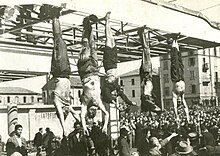Clara Petacci
This article needs additional citations for verification. (April 2014) |
Clara Petacci | |
|---|---|
 Petacci in the 1930s | |
| Born | 28 February 1912 |
| Died | 28 April 1945 (aged 33) Giulino di Mezzegra, Italy |
| Nationality | Italian |
| Known for | Being the mistress of Benito Mussolini |
| Partner(s) | Benito Mussolini (1933–1945) |
| Relatives | Miriam di San Servolo (sister) Marcello Petacci (brother) |
Clara Petacci, known as Claretta Petacci (Italian: [klaˈretta peˈtattʃi]; 28 February 1912 – 28 April 1945), was a mistress of the Italian dictator Benito Mussolini. She was killed during Mussolini's execution by Italian partisans, allegedly throwing herself on him in a vain attempt to protect him from the bullets.[1]
Early life[]
Daughter of Giuseppina Persichetti (1888–1962) and the physician Francesco Saverio Petacci (1883–1970), Clara Petacci was born into a privileged and religious family in Rome during 1912.[2][3] Her father was physician of the Holy Apostolic Palaces[4] and a supporter of fascism. A child when Mussolini rose to power, she idolised him from an early age. In 1926, when Violet Gibson attempted to assassinate the dictator, 14-year-old Petacci wrote to him commenting "O, Duce, why was I not with you? ... Could I not have strangled that murderous woman?"[5]
Relationship with Mussolini[]
Petacci had a long-standing relationship with Mussolini while he was married to Rachele Mussolini. Petacci was 28 years younger than Mussolini.[6] They met for the first time in 1933; in 1934 Petacci married Italian Air Force officer Riccardo Federici, but she parted ways with her husband when he was sent as Air Attaché to Tokyo in 1936.[7]
Part of Petacci and Mussolini's correspondence is still the subject of a dispute with the National Archives,[which?] based on privacy.[8]
Death[]

On 27 April 1945, Mussolini and Petacci were captured by partisans while traveling with a convoy of Italian Social Republic members.[9]
On 28 April, she and Mussolini were taken to Mezzegra and executed. On the following day, the bodies of Mussolini and Petacci were taken to Piazzale Loreto in Milan and hung upside down in front of an Esso petrol station. The bodies were photographed as a crowd vented their rage upon them.[10]
In popular culture[]
show This section may be expanded with text translated from the corresponding article in Italian. (July 2020) Click [show] for important translation instructions. |
- Caesar and Claretta, a 1975 episode of the BBC-TV program Private Affairs, starring Helen Mirren
- Claretta, 1984 film starring Claudia Cardinale
- Mussolini: The Untold Story, 1985 TV-miniseries featured Virginia Madsen as Petacci
- Mussolini and I, in which she is played by Barbara De Rossi
See also[]
- Margherita Sarfatti, one of Mussolini's earlier mistresses
- Eva Braun, Adolf Hitler's mistress
References[]
- ^ Pierluigi Baima Bollone, Le ultime ore di Mussolini, Milano, Mondadori, 2005, ISBN 88-04-53487-7., pagg. 89 e succ.ve
- ^ Barber, Tony (17 February 2017). "Claretta by RJB Bosworth — Mussolini's last lover". www.ft.com. Retrieved 2021-04-02.
- ^ Downing, Ben (2017-03-24). "In Bed With Il Duce". Wall Street Journal. ISSN 0099-9660. Retrieved 2021-04-02.
- ^ De Felice (1981) p. 278
- ^ Thomson, Ian (25 February 2017). "The Ben and Clara affair". www.spectator.co.uk. Retrieved 2021-04-02.
- ^ (in Spanish) Giuseppina Persichetti, La enamorada de Mussolini, Madrid, Ediciones Caballero Audaz, 1947.
- ^ Bosworth, R.J.B. (2010). Mussolini. Bloomsbury.
- ^ (in Italian) Giampiero Buonomo, Quel carteggio tra Mussolini e la Petacci. Storici sacrificati sull’altare della privacy, in Diritto e giustizia, 16 luglio 2005.
- ^ Gunther Langes, Auf Wiedersehen Claretta. Il diario dell'uomo che poteva salvare Mussolini e la Petacci, a cura di Nico Pirozzi, Villaricca, Edizioni Cento Autori, 2012. ISBN 978-88-97121-37-4.
- ^ "Death of the Father-Mussolini & Fascist Italy: the 'infamous' exhibit". Cornell Institute for Digital Collections. 1999.
Sources[]
- De Felice, Renzo (1996) [1981]. Mussolini. Il Duce. 2: Lo stato totalitario, 1936–1940 (in Italian) (2 ed.). Torino: Einaudi.
Further reading[]
| Wikimedia Commons has media related to Clara Petacci. |
- Bosworth, R.J.B. (2017). Claretta: Mussolini's Last Lover, Yale University Press ISBN 978-0300214277
- Farrell, Nicholas (2003). Mussolini: A New Life, Phoenix Press: London ISBN 1-84212-123-5
- Garibaldi, Luciano (2004). Mussolini: The Secrets of His Death, Enigma Books, New York ISBN 1-929631-23-5
- Moseley, Ray (2004). Mussolini: The Last 600 Days of Il Duce, Taylor Trade Publishing, Dallas ISBN 1-58979-095-2
- Mistresses of Benito Mussolini
- 1912 births
- 1945 deaths
- Executed Italian women
- 20th-century executions by Italy
- People from Rome
- People executed by Italy by firing squad
- 20th-century Italian women
